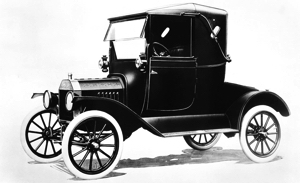No.03
We started with the factory idea: that you could change the whole world if you had an efficient factory that could churn out change. We then went to the TV idea, that said if you had a big enough mouthpiece, if you could get on TV enough times, if you could buy enough ads, you could win. And now we’re in this new model of leadership, where the way we make change is not by using money or power to lever a system, but by leading.
So let me tell you about the three cycles. The first one is the factory cycle. Henry Ford comes up with a really cool idea. It enables him to hire men who used to get paid 50 cents a day and pay them five dollars a day. Because he’s got an efficient enough factory. Well with that sort of advantage you can churn out a lot of cars. You can make a lot of change. You can get roads built. You can change the fabric of an entire country. That the essence of what you’re doing is you need ever-cheaper labor, and ever-faster machines. And the problem we’ve run into is, we’re running out of both. Ever-cheaper labor and ever-faster machines. (Laughter)
So we shift gears for a minute, and say, “I know: television; advertising. Push push. Take a good idea and push it on the world. I have a better mousetrap. And if I can just get enough money to tell enough people, I’ll sell enough.” And you can build an entire industry on that. If necessary you can put babies in your ads. If necessary you can use babies to sell other stuff. And if babies don’t work, you can use doctors. But be careful. Because you don’t want to get an unfortunate juxtaposition, where you’re talking about one thing instead of the other. (Laughter) This model requires you to act like the king, like the person in the front of the room throwing things to the peons in the back. That you are in charge, and you’re going to tell people what to do next. The quick little diagram of it is, you’re up here, and you are pushing it out to the world. This method — mass marketing — requires average ideas, because you’re going to the masses, and plenty of ads. What we’ve done as spammers is tried to hypnotize everyone into buying our idea, hypnotize everyone into donating to our cause, hypnotize everyone into voting for our candidate. And, unfortunately, it doesn’t work so well anymore either. (Laughter)
ボキャブラリー
We started with the factory idea: that you could change the whole world if you had an efficient factory that could churn out change. We then went to the TV idea, that said if you had a big enough mouthpiece, if you could get on TV enough times, if you could buy enough ads, you could win. And now we’re in this new model of leadership, where the way we make change is not by using money or power to lever a system, but by leading.
So let me tell you about the three cycles. The first one is the factory cycle. Henry Ford comes up with a really cool idea. It enables him to hire men who used to get paid 50 cents a day and pay them five dollars a day. Because he’s got an efficient enough factory. Well with that sort of advantage you can churn out a lot of cars. You can make a lot of change. You can get roads built. You can change the fabric of an entire country. That the essence of what you’re doing is you need ever-cheaper labor, and ever-faster machines. And the problem we’ve run into is, we’re running out of both. Ever-cheaper labor and ever-faster machines. (Laughter)
So we shift gears for a minute, and say, “I know: television; advertising. Push push. Take a good idea and push it on the world. I have a better mousetrap. And if I can just get enough money to tell enough people, I’ll sell enough.” And you can build an entire industry on that. If necessary you can put babies in your ads. If necessary you can use babies to sell other stuff. And if babies don’t work, you can use doctors. But be careful. Because you don’t want to get an unfortunate juxtaposition, where you’re talking about one thing instead of the other. (Laughter) This model requires you to act like the king, like the person in the front of the room throwing things to the peons in the back. That you are in charge, and you’re going to tell people what to do next. The quick little diagram of it is, you’re up here, and you are pushing it out to the world. This method — mass marketing — requires average ideas, because you’re going to the masses, and plenty of ads. What we’ve done as spammers is tried to hypnotize everyone into buying our idea, hypnotize everyone into donating to our cause, hypnotize everyone into voting for our candidate. And, unfortunately, it doesn’t work so well anymore either. (Laughter)
factory: n. 工場、製造所
efficient: a. 効率の良い、効率的な、高効率の、効果的な、有効な
churn out: 〜を乱造する、垂れ流す、大量生産する、量産する
mouthpiece: n. (菅・容器などの)口、口金;マウスピース
lever: vt. (てこで)〜を動かす、持ち上げる、こじ開ける、転がす(up, off)
cycle: n. 周期、サイクル、循環、繰り返し
Henry Ford: ヘンリー・フォード。《米国》1863-1947。自動車王。大量生産方式を採用した Model T 自動車で米自動車界を席捲、米自動車生産の60%にまで達した(1927年までに1500万台を販売)
come up with ~: (アイデアなどを)思い付く、考え付く、考え出す;(答えなどを)見つけ出す
enable: vt. 〜を可能にする、〜が(…)できるようにする
fabric: n. 骨組み、仕組み、基礎構造;建材、素材;織り方、編み方
ever-cheaper: a. かつてない安さの
ever-faster: a. かつてない速さの
run into ~: 偶然[思いがけなく・ばったり]〜に出会う、〜に出くわす[遭遇する];〜にぶつかる、ぶちあたる
run out of ~: 〜を使い果たす、(品物などを)切らす、(時間などが)なくなる
shift gear: ギアを変える
mousetrap: n. ネズミ捕り
juxtaposition: n. 並列、並置、並べること、並記
instead of ~: 〜の代わりに
peon: n. (中南米の)農場[日雇い]労働者;(米・けなして)こき使われる労働者
in charge: (人が物を)管理して、監督して、統括して、仕切って、掌握して;(仕事などを)担当して;責任を負って、責任者で
mass marketing: ますマーケティング、大量販売、大量生産
the masses: n. 一般大衆、庶民
spammer: n. スパマー、スパムを送信する人、スパム業者
hypnotize: vt. 〜に催眠術をかける、うっとりさせる、〜の心を奪う
donate: vi. (…に)寄付[寄贈、提供]する(to ~)
vote for ~: 〜に賛成の投票をする
解説
ヘンリー・フォード

(Henry Ford 、1863年7月30日 – 1947年4月7日)は、アメリカ合衆国出身の企業家、自動車会社フォード・モーターの創設者であり、工業製品の製造におけるライン生産方式による大量生産技術開発の後援者である。フォードは自動車を発明したわけではないが、アメリカの多くの中流の人々が購入できる初の自動車を開発・生産した。カール・ベンツが自動車の産みの親であるなら、自動車の育ての親はヘンリー・フォードとなる。T型フォードは、世界で累計1,500万台以上も生産され、産業と交通に革命をもたらした。フォード・モーターの社主として、世界有数の富豪となり、有名人となった。安価な製品を大量生産しつつ労働者の高賃金を維持する「フォーディズム」の創造者である。フォードはまた、消費者優先主義が平和の鍵だというグローバルなビジョンを持っていた。体系的なコスト削減を強力に推進し、多くの技術革新やビジネス上の革新をもたらした。例えば、北米全土および世界の主要都市にフランチャイズシステムによる販売店網を確立した。遺産のほとんどをフォード財団に遺したが、遺族がその組織を恒久的に運営できるよう手配した。
第一次世界大戦のころには平和主義を主張したことで知られているが、『国際ユダヤ人』という書籍を出版するなど反ユダヤ主義者としても知られている。(ウィキペディアより)
フォードモデルT(1917年型)
